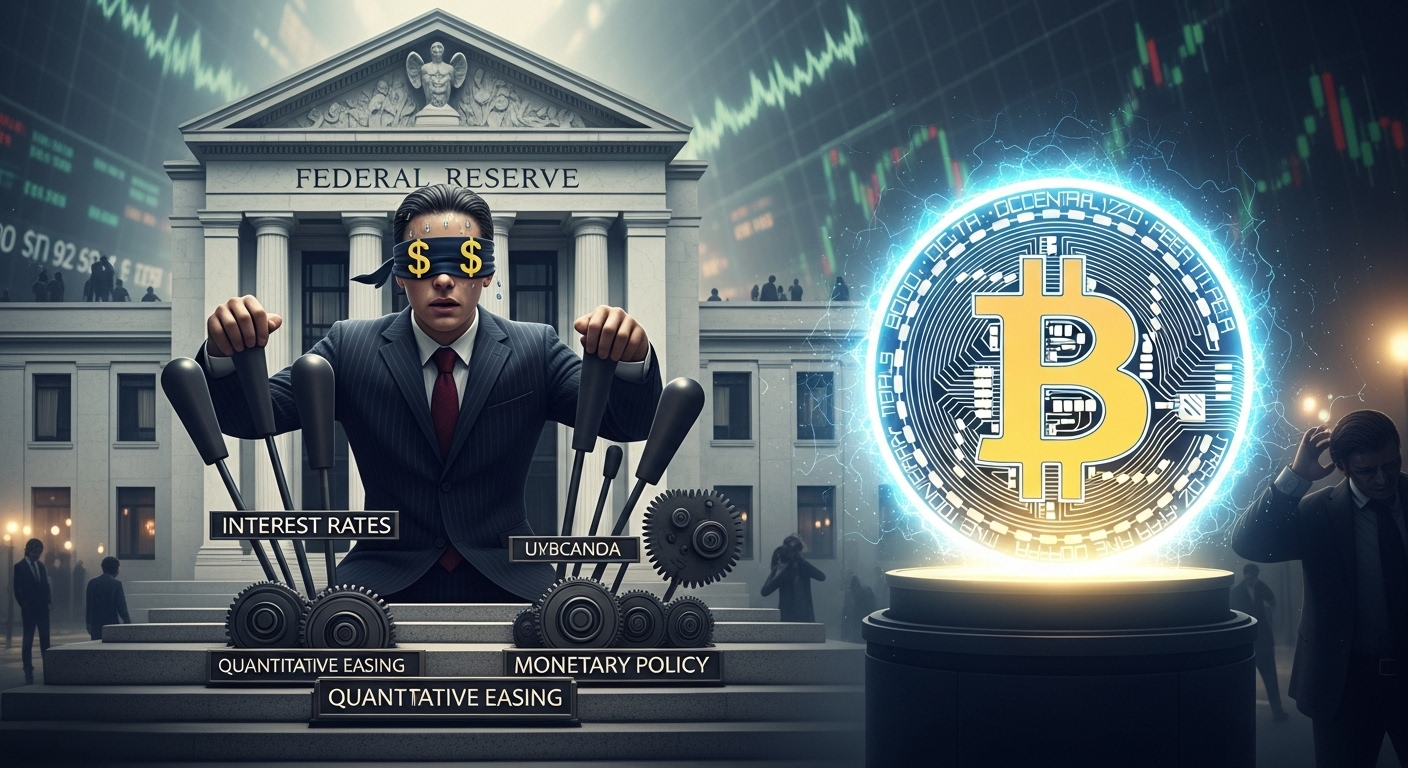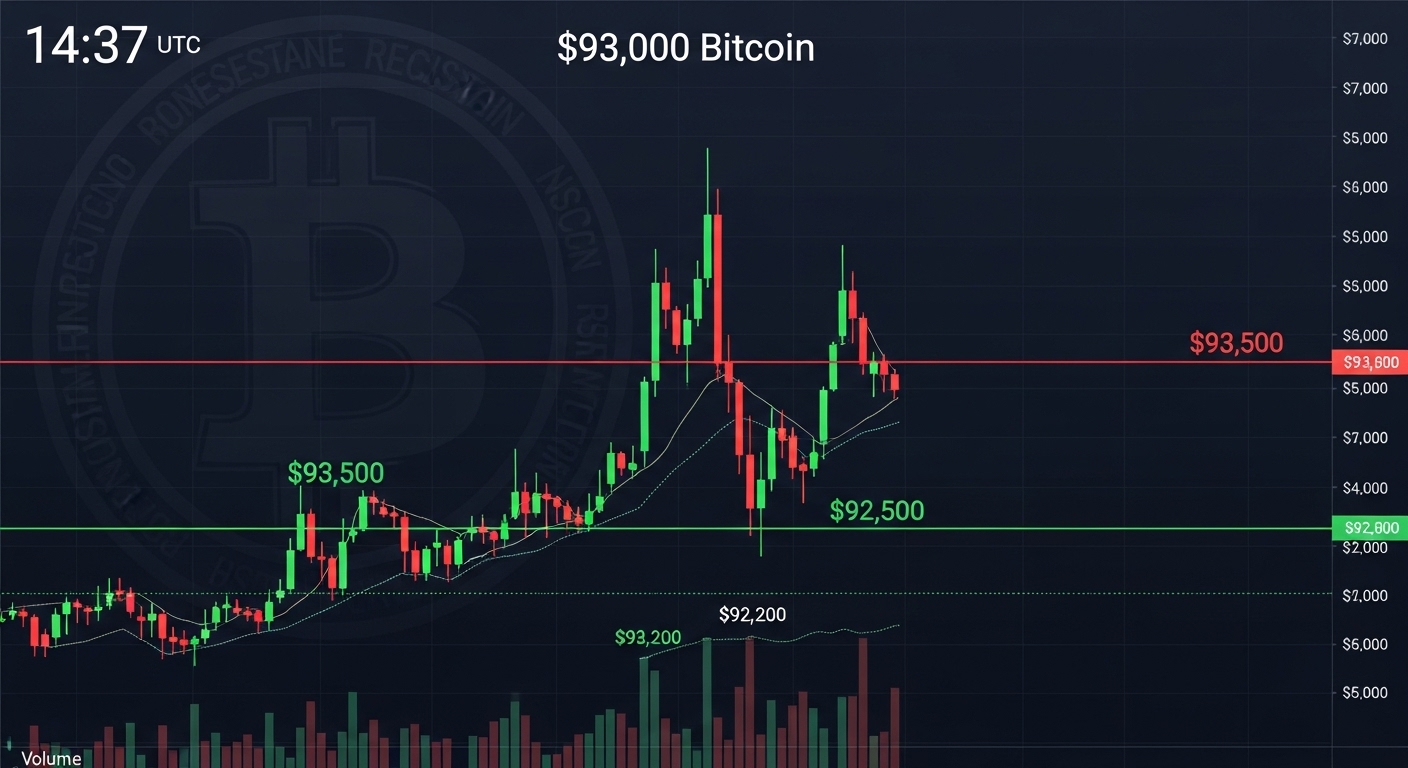Bitcoin’s Price Dips to $93K Ahead of ‘Blind’ Fed
Bitcoin falls to $93K as ETF outflows swell and a “blind” Fed stirs concern. Explore what’s driving BTC, key levels, and what comes next.

Bitcoin’s latest pullback to around $93,000 has garnered global attention, not simply because of the number itself but because of the context that surrounds it. After reaching new highs earlier in the year, the price of the world’s largest cryptocurrency has slipped while traders confront a rather unusual situation: a Federal Reserve that must act with limited visibility into the economy. Bitcoin’s Price Dips. With U.S. economic data flows disrupted by a government shutdown, policymakers are moving into a key decision-making window without the usual arsenal of statistics.
At the same time, spot Bitcoin ETFs are recording significant outflows and risk sentiment across financial markets is wavering. In this environment, Bitcoin’s price decline to $93,000 is not merely a correction—it reflects a deeper recalibration of risk, growth expectations, and policy uncertainty. In what follows, we will unpack the forces driving the recent decline, assess how a “blind” Fed influences the marketplace, analyze trader positioning around critical levels, and review the longer-term narratives around Bitcoin as digital gold, inflation hedge, and institutional asset.
The road to $93,000: How Bitcoin got here
From new highs to a cooling market
Bitcoin’s movement toward the $93,000 zone did not occur in a vacuum. The prior rally had been fuelled by a combination of institutional flows, ETF enthusiasm, and retail momentum. As the upward momentum matured, warning signs began to surface. Spot ETFs that were initially drawing strong inflows began to reverse direction, signaling some measure of profit-taking and risk-off behavior.
Simultaneously, major U.S. stock indices which had carried the broader risk-on mood started losing steam. The result was a gradual shift from euphoria to caution. When Bitcoin’s price re-tested the low ninety-thousand region, it marked a turning point where macro considerations overtook the prior bullish narrative.
ETF flows, leverage, and profit-taking
A key background driver of the Bitcoin price dynamics in this cycle has been the behavior of ETFs and leveraged participants. When institutional investors start redeeming ETF shares, issuers often need to sell physical Bitcoin, adding actual selling pressure in the spot market. The recent wave of outflows from Bitcoin ETFs signals less appetite from the large holders, and indicates a retreat from risk.
Concurrently, on-chain and derivatives data reveal that many traders had been using high leverage to chase upside. As Bitcoin began to rollover from its highs, long positions were liquidated at pace. Prior episodes where Bitcoin dipped toward the mid-$90,000s amid Fed concerns illustrate how quickly leveraged trades can unwind and accelerate a decline. Together, these institutional and derivative flows helped push Bitcoin toward the $93,000 mark.
What does a “blind” Fed mean for Bitcoin?

Data blackout and policy uncertainty
In normal times, the Federal Reserve leans heavily on economic indicators such as employment numbers, inflation data, retail sales, and GDP to shape its interest-rate decisions. However, due to the U.S. government shutdown, much of that data has been delayed or thrown into uncertainty. With fewer clear signals at their disposal, Fed policymakers are navigating conditions with less visibility than usual.
That ambiguity matters for Bitcoin because when a major central bank is operating with diminished clarity, uncertainty rises across financial markets. Traders often interpret a “blind” Fed as a higher risk environment for speculative assets because the probability of a surprise move increases. In such environments volatility tends to rise and risk assets typically come under pressure.
Why interest-rate expectations matter for BTC
Even though Bitcoin does not pay interest and is not a traditional fixed-income asset, interest-rate expectations exert a strong influence on its price dynamics. When interest rates climb, cash and bonds become more attractive relative to speculative assets, which tends to dampen risk appetite. Conversely, when rates fall or are expected to fall, risk assets often benefit.
Throughout 2025, traders have been continually repositioning around expectations for the Fed’s next move—whether the next step is a hike, a pause, or a cut. Markets that fear tighter policy or delayed cuts have often exerted downward pressure on Bitcoin’s price, sometimes driving it toward zones like $92,000 or $95,000. In the current scenario of a “blind” Fed, the path of policy feels wider and less predictable. That ambiguity translates into a higher risk premium for speculative assets like Bitcoin.
Macro risk-off mood spills into crypto
Correlation with stocks and other risk assets
Although Bitcoin is often promoted as non-correlated or a safe-haven asset, in practice it tends to move in tandem with equities when macro uncertainty grows. When investors de-risk, they rarely isolate their sales to one asset class; rather, they tend to reduce exposure across high-beta assets including tech stocks and crypto.
With recent signs of weakening in major U.S. indices and concerns about economic growth and inflation, risk appetite has weakened. In such an environment, Bitcoin is not immune; instead it often acts like a leveraged risk asset. The movement toward the $93,000 level reflects this broader re-pricing of risk rather than a purely crypto-specific event.
Government shutdown, data paralysis, and sentiment
The U.S. government shutdown has created a ripple effect far beyond domestic politics. By halting or delaying critical economic releases, confidence in the reliability of official data has weakened. Investors are forced to rely on less-trusted or delayed metrics, increasing uncertainty about growth, labor markets, and inflation.
For Bitcoin traders this means that the usual maps of economic indicators are less clear, and the terrain is more unpredictable. When visibility drops, volatility tends to rise and markets often demand a premium for risk. This backdrop helps explain why Bitcoin found itself retracing to around $93,000—because the usual anchors of confidence have been temporarily loosened.
Technical picture: key levels around $93,000

Support, resistance, and the battle for trend control
From a technical perspective, the range between roughly $90,000 and $95,000 has emerged as a significant battleground during 2025. Prior dips toward $92,500 and sub-$95,000 levels were tied to episodes of increased fear around Fed policy and macro data. In many of those episodes, Bitcoin eventually recovered, but the path was volatile and uncertain.
With the price now revisiting approximately $93,000, traders and analysts are closely watching whether support holds or cracks. If bulls can defend this zone and reclaim higher territory, the correction may simply be a pause in a larger uptrend. If instead support fails, it could signal a deeper retracement.
Market structure, leverage, and liquidity zones
Beyond simple price levels, the broader structure of the market and where liquidity resides matter a great deal. Analysts studying derivatives and order-book data point out that clusters of large stop-loss orders and liquidation points often sit near key levels, and when triggered they can create sharp moves.
At around $93,000, the market appears to be in a holding pattern: not necessarily panic mode, but certainly cautious and wary. The behavior of futures open interest, options skew, and spot liquidity around this zone will help determine whether the current dip morphs into a deeper shake-out or simply resolves into a consolidation.
How traders are positioning into the Fed
Short-term strategies: hedging and range trading
With Bitcoin hovering near $93,000 and the Fed’s next move clouded by data uncertainty, many short-term traders are pivoting toward more conservative strategies. Some are using options to hedge potential downside while retaining upside exposure. Others are engaging in range trading between identified support and resistance levels rather than chasing breakout moves.
Many are also reducing leverage altogether, opting to trade spot rather than futures in order to avoid forced liquidations during sudden market shifts. In effect, traders are treating this period not as a time for bold directional bets but as a time for nimble positioning and discipline.
Long-term investors: zooming out on the macro chart
While traders focus on candles, volumes, and Fed minutes, longer-term investors tend to look at broader structural themes. For them the current pullback to $93,000 may simply be a moment to reaffirm core convictions. Those convictions include themes such as Bitcoin’s role as digital gold, its scarcity value (with a capped supply).
And its growing institutional adoption via ETFs, corporate balance sheets, and professional fund flows. Historically, large drawdowns within a bull cycle have often been followed by renewed rallies to higher highs. From this vantage, the current move could be seen less as a final top and more as part of the normal rhythm of volatility inherent in Bitcoin’s market. But even the most committed long-term investors recognize that macro conditions—especially a Fed operating in the dark—can prolong corrections beyond expectation.
What could happen after the Fed decision?
Scenario one: Hawkish surprise and deeper downside
If the Fed, facing uncertain data, chooses to adopt a more hawkish tone—signaling fewer cuts or a longer-for-longer stance on rates—then risk assets could come under renewed pressure. In that scenario Bitcoin’s price may revisit support zones below $93,000, potentially testing levels near $90,000 or even lower that have been flagged in recent analysis. Large institutional outflows could accelerate, leveraged longs may trigger liquidations, and the risk-off narrative could dominate the crypto space once again.
Scenario two: Dovish turn and relief rally
Alternatively, if the Fed signals a more dovish policy path—expressing confidence that inflation is easing and indicating the possibility of cuts or rate stabilization—the market’s response could be more positive. Bitcoin could then see renewed demand as risk appetite returns and institutions reposition into speculative assets. Spot ETF flows could reverse, and a reclaim of six-figure territory could become a possibility if macro data stabilizes \
once the government shutdown ends and the data blackout lifts. Yet even in this scenario the move may not be immediate; sometimes the actual relief‐rally comes only after the initial joy is digested, especially when markets have already priced in optimism.
See More: Bitcoin price jumps as crypto stocks rally 2 drivers behind the surge
Long-term outlook: Is $93,000 a warning or an opportunity?
Balancing risk management and conviction
For investors and traders alike the question is not simply whether Bitcoin’s price will move up or down after the next Fed event, but how to manage risk while maintaining conviction. On one hand, the uncertainty of a Fed operating without full visibility adds to the risk side: macro shocks, policy surprises, and system-wide stress could all spill into crypto. On the other hand, the structural drivers behind Bitcoin—scarcity, institutional adoption, global monetary expansion—remain firmly in place.
As such the dip to $93,000 can be viewed simultaneously as a “warning” about not being complacent, and as a possible “opportunity” for those who believe in the long-term thesis. The key for any participant is to calibrate exposure according to one’s own time horizon, risk tolerance, and belief in Bitcoin’s role in the future financial system.
The importance of strategy in a macro-driven market
In an era where macro policy and monetary decisions dominate market psychology, strategies must adapt. Short-term traders may see this moment as one for hedging and tactical moves. Medium-term swing players might wait for confirmations such as a clear Fed pivot or a reclaim of key technical levels. Long-term holders may view the noise as part of the normal roller-coaster ride that has characterized Bitcoin’s rise.
Importantly, regardless of the timeline, having a clearly defined plan—entry, exit, and risk management—is essential when markets are driven by policy uncertainty. Bitcoin’s price will continue to be sensitive to the path of interest rates, growth expectations, and liquidity. Navigating this environment successfully demands discipline, adaptability, and an appreciation for both the risks and the potential rewards.
Final thoughts
Bitcoin’s drop to roughly $93,000, set against the backdrop of a “blind” Fed, mounting ETF outflows, and broader macro unease, underscores a critical reality: crypto remains deeply connected to the broader financial ecosystem. The Bitcoin price today is shaped not solely by halving cycles or adoption curves, but also by central-bank policy, government shutdowns, data unreliability, and the shifting appetite for risk. For traders the message is caution and readiness. For long-term believers the message is patience and conviction.
Across both camps the fundamental truth is that volatility and uncertainty travel hand in hand—and they often create the conditions for both drawdowns and opportunity. As the Fed navigates its next moves and markets await clarity, Bitcoin remains at the center of the global financial conversation around money, risk, and value. Whether $93,000 becomes a mere pause in the uptrend or the start of a deeper correction depends on how the tone from policymakers interacts with investor behavior. Regardless, this moment demands attention and care from anyone invested in the future of crypto.



